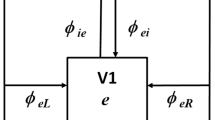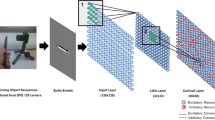Abstract
The map from eye to brain in vertebrates is topographic, i.e. neighbouring points in the eye map to neighbouring points in the brain. In addition, when two eyes innervate the same target structure, the two sets of fibres segregate to form ocular dominance stripes. Experimental evidence from the frog and goldfish suggests that these two phenomena may be subserved by the same mechanisms. We present a computational model that addresses the formation of both topography and ocular dominance. The model is based on a form of competitive learning with subtractive enforcement of a weight normalization rule. Inputs to the model are distributed patterns of activity presented simultaneously in both eyes. An important aspect of this model is that ocular dominance segregation can occur when the two eyes are positively correlated, whereas previous models have tended to assume zero or negative correlations between the eyes. This allows investigation of the dependence of the pattern of stripes on the degree of correlation between the eyes: we find that increasing correlation leads to narrower stripes. Experiments are suggested to test this prediction.
Similar content being viewed by others
References
Aguilar-Chongtay R (1992) The role of correlations in the development of the visual system. Unpublished MSc thesis, University of Edinburgh
Arnett DW (1978) Statistical dependence between neighbouring retinal ganglion cells in goldfish. Exp Brain Res 32:49–53
Constantine-Paton M (1983) Position and proximity in the development of maps and stripes. Trends Neurosci 6:32–36
Constantine-Paton M, Law MI (1978) Eye-specific termination bands in tecta of three-eyed frogs. Science 202:639–641
Constantine-Paton M, Law MI (1982) The development of maps and stripes in the brain. Sci Am 247:54–62
Cowan JD, Friedman AE (1991) Studies of a model for the development and regeneration of eye-brain maps. In: Touretzky DS (eds) Advances in neural information processing systems, 3. Morgan Kaufmann, CA, pp 3–10
Dayan PS (1993) Arbitrary elastic topologies and Ocular dominance. Neural Computation 5:392–401
Dayan PS, Goodhill GJ (1992) Perturbing Hebbian rules. In: Moody JE, Hanson SJ, Lippman RP (eds) Advances in neural information processing systems, 4. Morgan Kaufmann, CA, pp 19–26
Fraser SE (1980) A differential adhesion approach to the patterning of neural connections. Dev Biol 79:453–464
Fraser SE (1985) Cell interactions involved in neural patterning. In: Edelman GM, Gall WE, Cowan WM (eds) Molecular bases of neural development. Wiley, New York, pp 481–507
Fraser SE, Perkel DH (1990) Competitive and positional cues in the patterning of nerve connections. Neurobiol 21:51–72
Ginsburg KS, Johnsen JA, Levine MW (1984) Common noise in the firing of neighbouring ganglion cells in goldfish retina. J Physiol (Lond) 351:433–450
Goodhill GJ (1992) The development of topography and ocular dominance. In: Touretzky DS, Elman JL. Sejnowski TJ, Hinton GS (eds) Proceedings of the 1990 Connectionist Models Summer School. Morgan Kaufmann, CA, pp 338–349
Goodhill GJ (1991a) Topography and ocular dominance can arise from distributed patterns of activity. International Joint Conference on Neural Networks, Seattle, July, II:623–627
Goodhill GJ (1991b) Correlations, competition and optimality: modelling the development of topography and ocular dominance. PhD thesis, Sussex University
Goodhill GJ (1993) Topography and ocular dominance with positive correlations. In: Giles CL, Hanson SJ, Cowan JD (eds) Advances in neural information processing system, (5) Morgan Kaufmann, CA
Goodhill GJ, Barrow HG (1992b) The role of weight normalization in competitive learning. Submitted to Neural Computation
Goodhill GJ, Willshaw DJ (1990) Application of the elastic net algorithm to the formation of ocular dominance stripes. Network 1:41–59
Häussler AF, Malsburg C von der (1983) Development of retinotopic projections: an analytical treatment. J Theor Neurobiol 2:47–73
Hendrickson AE (1985) Dots, stripes and columns in monkey visual cortex. Trends Neurosci 8:406–410
Hertz J, Krogh A, Palmer RG (1991) Introduction to the theory of neural computation. Lecture notes in the Sante Fe Institute Studies in the sciences of complexity: Addison Wesley
Horton JC, Dagi LR, McCrane EP, de Monasterio FM (1990) Arrangement of ocular dominance columns in human visual cortex. Arch Ophthalmol 108:1025–1031
Hubel DH (1988) Eye, brain, and vision. (Scientific American Library) Freeman, New York
Hubel DH, Wiesel TN (1965) Binocular interaction in striate cortex of kittens reared with artificial squint. J Neurophysiol 28:1041–1059
Hubel DH, Wiesel TN (1977) Functional architecture of the macaque monkey visual cortex. Proc R Soc Lond [Biol] 198:1–59
Ide CF, Fraser SF, Meyer RL (1983) Eye dominance columns formed by an isogenic double-nasal frog eye. Science 221:293–295
Jones DG, Van Sluyters RC, Murphy KM (1991) A computational model for the overall pattern of ocular dominance. J Neurosci 11:3794–3808
Kohonen T (1982) Self-organized formation of topologically correct feature maps. Biol Cybern 43:59–69
Kohonen T (1988) Self-organization and associative memory, 3rd ed. Springer, Berlin Heidelberg New York
Malsburg C von der (1973) Self-organization of orientation sensitive cells in the striate cortex. Kybernetik 14:85–100
Malsburg C von der (1979) Development of ocularity domains and growth behaviour of axon terminals. Biol Cybern 32:49–62
Malsburg C von der, Singer W (1988) Principles of cortical network organization. In: Rakic P, Singer W (eds) Neurobiology of Neocortex. Wiley, New York, pp 69–99
Malsburg C von der, Willshaw DJ (1976) A mechanism for producing continuous neural mappings: ocularity dominance stripes and ordered retino-tectal projections. Exp Brain Res [Suppl] 1:463–469
Malsburg C von der, Willshaw DJ (1977) How to label nerve cells so that they can interconnect in an ordered fashion. Proc Natl Acad Sci USA 74:5176–5178
Mastronade DN (1989) Correlated firing of retinal ganglion cells. Trends Neurosci 12(2):75–80
Meister M, Wong ROL, Baylor DA, Shatz CJ (1991) Synchronous bursts of action potentials in ganglion cells of the developing mammalian retina. Science 252:939–943
Miller KD, Keller JB, Stryker MP (1989) Ocular dominance column development: analysis and simulation. Science 245:605–615
Miller KD, MacKay DJC (1993) The role of constraints in Hebbian learning. To appear in Neural Computation
Obermayer K, Ritter H, Schulten K (1991) A principle for the formation of the spatial structure of cortical feature maps. Proc Natl Acad Sci USA 87:8345–8349
Obermayer K, Ritter H, Schulten K (1991) Development and spatial structure of cortical feature maps: a model study. In: Lippmann RP, Moody J, Touretzky DS (eds) Neural information processing systems 2. Morgan Kaufmann, CA
Swindale NV (1980) A model for the formation of ocular dominance stripes. Proc R Soc Lond [Biol] 208:243–264
Udin SB, Fawcett JW (1988) Formation of topographic maps. Annu Rev Neurosci 11:289–327
Whitelaw VA, Cowan JD (1981) Specificity and plasticity of retinotectal connections: a computational model. J Neurosa 1:1369–1387
Willshaw DJ, Malsburg C von der (1976) How patterned neural connections can be set up by self-organization. Proc R Soc Lond [Biol] 194:431–445
Willshaw DJ, Malsburg C von der (1979) A marker induction mechanism for the establishment of ordered neural mappings: its application to the retinotectal problem. Philos Trans R Soc Lond [Biol] 287:203–243
Yuille AL, Kolodny JA, Lee CW (1991) Dimension reduction, generalized deformable models and the development of ocularity and orientation. International Joint Conference on Neural Networks, Seattle, July, II:597–602
Author information
Authors and Affiliations
Rights and permissions
About this article
Cite this article
Goodhill, G.J. Topography and ocular dominance: a model exploring positive correlations. Biol. Cybern. 69, 109–118 (1993). https://doi.org/10.1007/BF00226194
Received:
Accepted:
Issue Date:
DOI: https://doi.org/10.1007/BF00226194




